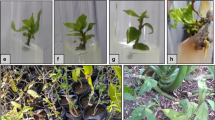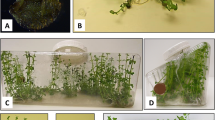Abstract
Melaleuca alternifolia is cultivated for the production of an essential oil useful in the cosmetic and pharmaceutical industries. Despite the economic importance of this species, there is little knowledge about its in vitro propagation. The aim of this study was to establish an efficient protocol for micropropagation of M. alternifolia. With the goal of in vitro multiplication by axillary shoot proliferation, both solid and liquid MS and WPM media were tested with supplementation with BA at 0, 0.55, 1.11, 2.22, 3.33, and 4.44 μM. The best result for shoot multiplication was obtained when either 0.55 μM BA was added into solid MS medium or 1.11 μM BA was added into liquid MS medium, with 5.6 and 11.8 shoots per explant generated, respectively. On solid or liquid WPM medium supplemented with 0.55 μM BA, the proliferation rates were 5.5 and 4.7, respectively. Three auxins (NAA, IAA, and IBA) were tested at 0.53 and 2.64 μM during the rooting stage. Several sucrose concentrations (15, 30, and 45 g L−1) were compared to a sucrose-free medium. Rooting performances on four culture media were then compared: MS, half-strength MS (MS/2), MS + activated charcoal (AC), and MS/2 + AC. The results showed that auxin addition to culture medium is not necessary for in vitro rooting. Rooted microcuttings from different culture media were acclimatized in a greenhouse, and the survival percentage was evaluated. All shoots cultured in an auxin-free MS medium supplemented with sucrose (30 g L−1) produced roots, and all plants survived during acclimatization. Activated charcoal added in rooting medium reduced rooting rates.


Similar content being viewed by others
References
Bhatt I. D.; Dhar U. Factors controlling micropropagation of Myrica esculenta buch.–Ham, ex D. Don: a high value wild edible of Kumaun Himalaya. Afric. J Biotechnol 3: 534–540; 2004.
Bopana N.; Saxena S. In vitro propagation of a high value medicinal plant: Asparagus racemosus Willd. In Vitro Cell Dev Biol Plant 44: 525–532; 2008.
Compton M. E.; Pierson B. L.; Staub J. E. Micropropagation for recovery of Cucumis hystrix. Plant Cell Tiss Organ Cult 64: 53–67; 2001.
Costa T. D.; Zaffari G. R. Micropropagation of Ananas bracteatus (Schultz) var. striatus Hort. Rev Bras Hortic Ornam 11: 109–113; 2005.
De Paoli G.; Subirà E.; Battistini A. In vitro rooting of Pyrodwarf and Cydomalus, two rootstocks for pear, under photoautotrophic conditions. Acta Hortic 596: 463–467; 2002.
EMBRAPA. Núcleo Tecnológico para Informática. SOC–Software Científico. Campinas, 1990.
George E. F. Plant propagation by tissue culture. Part 2: In Practice. 2nd ed. Exegetics, Edington, p 1361; 1996.
Homer L. E.; Leach D. N.; Lea D.; Lee L. S.; Henry R. J.; Baverstock P. R. Natural variation in the essential oil content of Melaleuca alternifolia Cheel (Myrtaceae). Biochem Syst Ecol 28: 367–382; 2000.
Iapichino G.; Airò M. Micropropagation of Metrosideros excelsa. In Vitro Cell Dev Biol Plant 44: 330–337; 2008.
Isutsa D. K. Rapid micropropagation of passion fruit (Passiflora edulis Sims.) varieties. Sci Hortic 99: 395–400; 2004.
Ito K.; Doi K.; Tatemichi Y.; Shibata M. Plant regeneration of Eucalyptus from rotating nodule cultures. Plant Cell Rep 16: 42–45; 1996.
Kiong A. L. P.; Huan H. H.; Hussein S. Callus induction from leaf explants of Melaleuca alternifolia. Intern J Agric Res 2: 227–237; 2007.
Lane W. D. Regeneration of apple plants from shoot meristem tips. Plant Science Letters 13:3 281–285, 1978.
Li M.; Leung D. W. M. Starch accumulation is associated with adventitious root formation in hypocotyl cuttings of Pinus radiata. J Plant Growth Regul 19: 423–428; 2000.
List S. E.; Brown P. H.; Low C. S.; Walsh K. B. A micropropagation protocol for Melaleuca alternifolia (tea tree). Aust J Exp Agric 36: 755–760; 1996.
Lloyd G.; McCown B. Commercially-feasible micropropagation of mountain laurel, Kalmia latifolia, by use of shoot-tip culture. International Plant Propagator’s Society. Proceedings 30: 421–427; 1980.
McCown B. H. Adventitious rooting of tissue cultured plants. In: Davis T. D.; Haissig B. E.; Sankhla N. (eds) Adventitious root formation in cuttings, vol. 2. Dioscorides, Portland, pp 289–302; 1988.
Mneney E. E.; Mantell S. H. Clonal propagation of cashew (Anacardium occidentale L.) by tissue culture. J Hortic Sci Biotechnol 6: 649–657; 2002.
Murashige T. Plant propagation through tissue cultures. Annu Rev Plant Physiol 25: 135–166; 1974.
Murashige T.; Skoog F. A revised medium for rapid growth and bioassay with tobacco tissue cultures. Physiol Plant 15: 473–497; 1962.
Ramanayake S. M. S. D.; Maddegoda K. M. M. N.; Vitharana M. C.; Chaturani G. D. G. Root induction in three species of bamboo with different rooting abilities. Sci Hortic 118: 270–273; 2008.
Riedl, R. W. Practical methods for using tea tree oil. Agro-Food Industry/Hi Tech. Ballina, set/oct, p. 34–36, 1997.
Thomas T. D. The role of activated charcoal in plant tissue culture. Biotechnol Adv 26: 618–631; 2008.
Vengadesan G.; Ganapathi A.; Amutha S.; Selvaraj N. In vitro propagation of Acacia species—a review. Plant Sci 163: 663–671; 2002.
Verma D. C.; Dougall D. K. Influence of carbohydrates on quantitative aspects of growth and embryo formation in wild carrot suspension cultures. Plant Physiol 59: 81–85; 1977.
Acknowledgments
The authors thank the Conselho Nacional de Pesquisas CNPq and Coordenação de Aperfeiçoamento de Pessoal de Nível Superior CAPES for providing a grant to Y. Oliveira and A. L. L. da Silva. The authors thank Luciana Ribas for helpful discussion and Eileen Bagyary for text revision.
Author information
Authors and Affiliations
Corresponding author
Additional information
Editor: N. J. Taylor
Rights and permissions
About this article
Cite this article
de Oliveira, Y., Pinto, F., da Silva, A.L.L. et al. An efficient protocol for micropropagation of Melaleuca alternifolia Cheel. In Vitro Cell.Dev.Biol.-Plant 46, 192–197 (2010). https://doi.org/10.1007/s11627-010-9287-6
Received:
Accepted:
Published:
Issue Date:
DOI: https://doi.org/10.1007/s11627-010-9287-6




